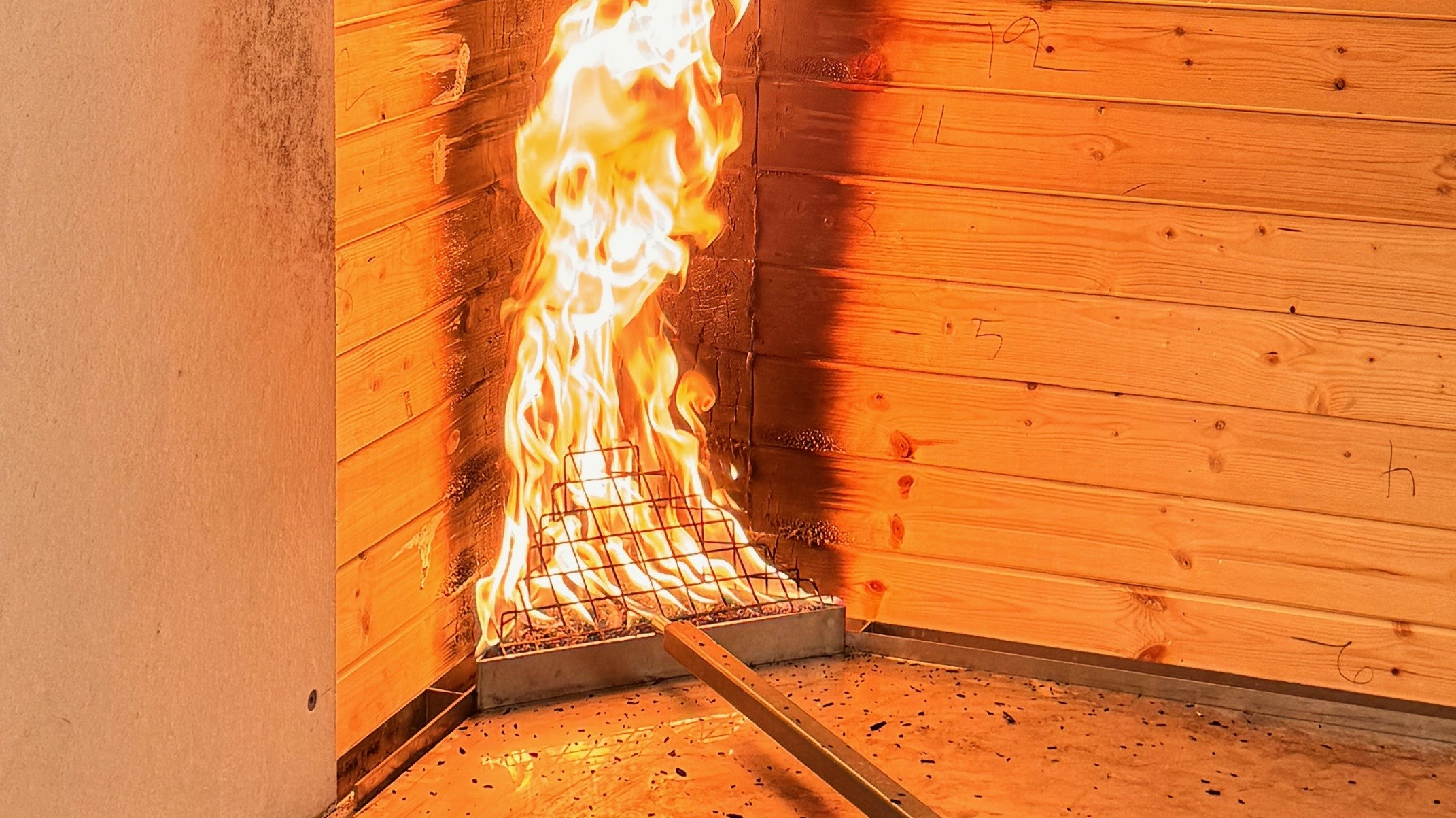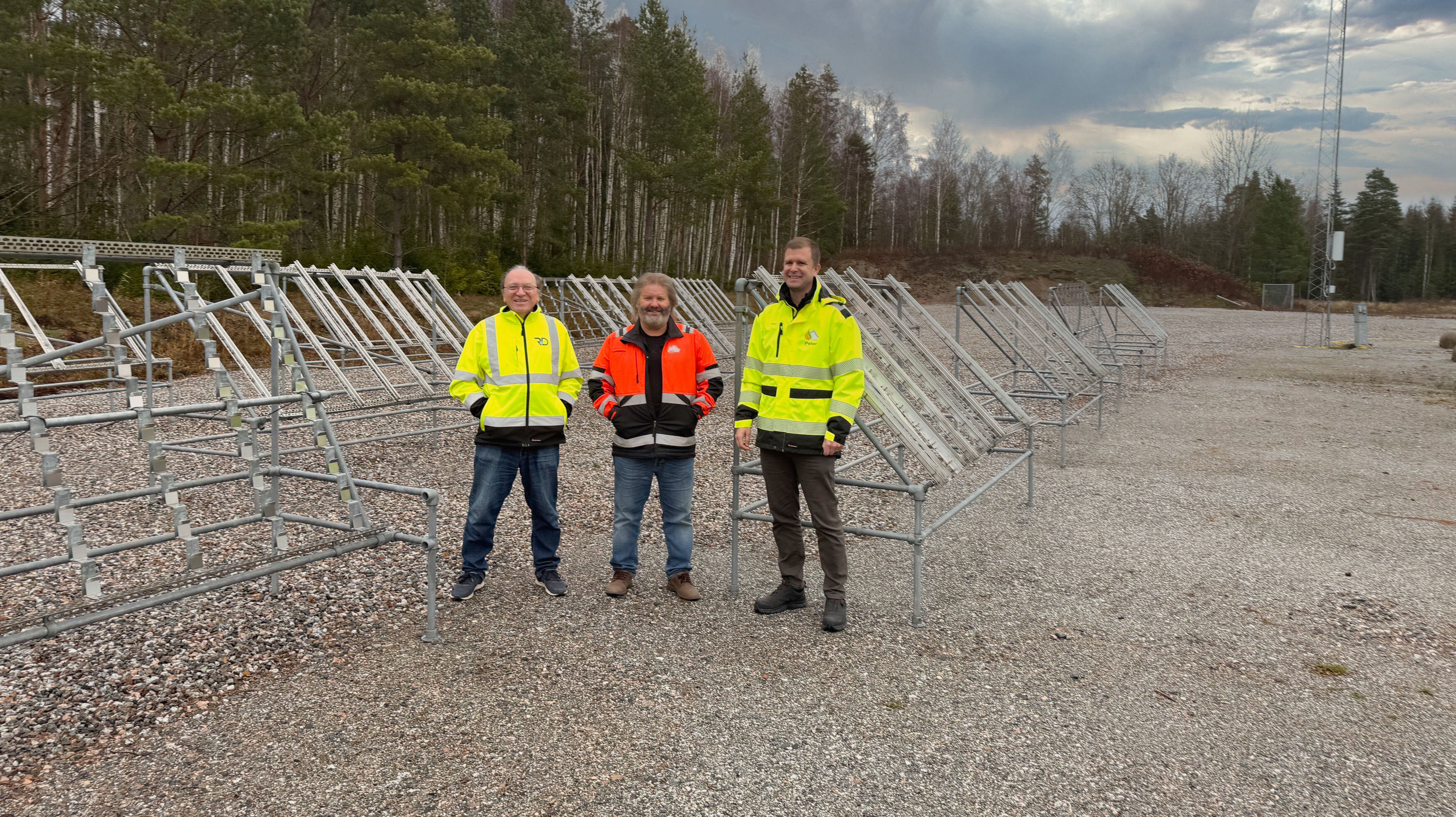Explanation of terms
There are many concepts, abbreviations, combinations of letters, numbers and not least many standards and paragraphs to keep in order. Just looking at the fire class, for example B-s1,d0, does not mean that the final product meets the requirements if the conditions have changed, for example surface treatment which, among other things, affects the Figra value.

Fire test report
Are results from fire testing, for example SBI EN13823.
The result is based on the specific condition of wood species, substrate, dimension and mounting conditions, for example air gap.
The fire test result does not constitute certification of either the product or the manufacturer.
Fire tests are carried out according to detailed information in relation to the current test standard, for example EN13823, EN14135.
Certificate/Certification
Certification means that something conforms to a certain specification, code or standard. Thus, a certificate is proof that these requirements are met.
However, certification also means that these requirements must be followed over time. This implies regular checks, such as that the holders of the certificates perpetuate their knowledge, or that a certified product complies with the certified copy.
Certification is performed under accreditation by SWEDAC, a government department. Simply put, one can say that certification under accreditation is equivalent to the old concept of "state authorisation".
In summary, there are four criteria that must be met in order to achieve certification:
- Regulatory compliances
- Compliance management
- Time limitation
- Accreditation
Notified bodies
Notified bodies are independent organisations with the expertise to assist in and monitor manufacturers' efforts to verify that the products they put on the market comply with the rules applicable within the EU. This takes place through testing, inspection and certification in accordance with EU legislation.
The name Notified Bodies comes from the fact that the Member State must notify approved bodies to the European Commission, which in turn assigns each notified body a four-digit identification number and publishes the name and address of the Commission's magazine, the Official Journal (OJ).
Each notified body also states within which area the organisation has the competence to act. A list of the notified bodies working within various areas is included in the Commission's public database Nando.
SWEDAC is the national notifying authority in Sweden, which means that it is SWEDAC that assesses and reports these bodies to the EU Commission. SWEDAC assesses and appoints Notified Body following consultation with the relevant authorities. The assessment is performed through accreditation, except where otherwise stipulated.
Under the Act on Accreditation and Conformity Assessment (2011: 791) 18 §, SWEDAC also exercises supervision of notified bodies. Supervision is performed in collaboration with sector authority.
CE certification
The purpose of Construction Product Regulation is that the conditions for the sale of construction products in the internal market should be uniform. This applies to construction products of solid wood EN14915:2013, and wood-based panels EN 13986:2004.
The Member States' requirements for buildings and other structures and for building product performance is the basis for whether a construction product is suitable for its intended use. The CE mark shows that the performance of the construction product has been assessed in accordance with the methods and criteria in a harmonised technical specification and that the manufacturer has drawn up a declaration of performance with data from this assessment.
Member States' building regulations are not harmonised by the Construction Products Regulation. In order to comply with national building regulations such as Boverket's BBR, the performance of the product and the manufacturer's quality must be ensured appropriately, as must third party production monitoring, which in practice means that the approval certificate is the only clear evidence that the requirements of the Planning and Building Act (SFS 2010: 900) are being met.
AVCP systems
Systems for the Assessment and Verification of Constancy of Performance.
The five different systems (termed 1, 1+, 2+, 3, 4) describe the tasks that a notified body must perform and the data that the manufacturer must perform themselves. AVCP systems are described in Annex V of CPR (amended in spring 2014).
For wood products whose natural performance against fire is changed as a result of treatment, the manufacturer is covered by AVCP system 1, which implies third-party production monitoring at the manufacturing site.
Rules and regulations for construction and construction products with certified properties
In order to meet the requirements, it is necessary to use the structures and construction products with suitable properties for the intended use. The term construction products refers to products manufactured for incorporation into permanent buildings. The term construction products with certified properties is a collective term for products whose properties have been substantiated during manufacture. This has implications for the degree of monitoring of product features that should be performed in the workplace in order to ensure that the product meets the requirements of the regulations. There are four different ways to certify the properties of construction products. These are:
a) Approval/production control
b) CE-marking
c) Product certification
d) Manufacturing and production control
Option a) Approval/production control is the only type of authentication implying monitoring of the fulfillment of Swedish requirements for the purposes specified in the certification. The developer must therefore ensure that approval/production controls actually refer to the current usage. If this is not the case, the product is treated in the same way as a product whose properties are certified under options b), c) or d). The options b), c) and d) means that the product is not checked against Swedish requirements, but merely that the developer must have confidence in the declaration of the characteristics of the supplied product. It is the developer who must check that these product characteristics are consistent with BBR requirements. They need not perform any tests of these properties other than determining whether the product is appropriate by examining the declaration.
Classification report
When a material is fire-tested, that material's performance can be classified according to classification standards, e.g. EN13501-1, which classifies EN13823.
The classification report does not constitute any certification of either the product or the manufacturer, it is merely a classification of product performance.
What is certification - conceptual confusion
To understand what certification is, it may be appropriate to describe what certification is not.
The word certification has become very popular and something of a buzzword. Unfortunately, it is used quite carelessly, probably due to ignorance.
The following example describes what is not classed as certification:
- After a completed fire testing, the client receives a fire test report. This is not the same as certification.
- After the completion of fire testing, product performance is determined and classified, entitled a classification report. This is a classification, but not a product certification.
- Some institutions/organisations, large and small, have the ability to print special documents where the aim is to clarify the product's performance. Such documents often have the title "Certificate", but the document's value based on a correct certifying document is non-existent.
CPR – Construction products regulation 305/2011
The Construction Products Regulation is fully applicable since 1 July, 2013. The regulation replaced the earlier CPD regulation. In Sweden, the main change is that that CE marking of construction products is now mandatory. The Swedish "Byggproduktförordningen" is so-called after the English title Construction Products Regulation.
The purpose of Construction Product Regulation is that the conditions for the sale of construction products in the internal market should be uniform.
This applies to construction products:
- Mandatory CE-marking for construction products covered by a harmonized standard or issued by the ETA. There are only very limited exceptions.
- It is not possible to CE mark a construction product directly against the regulation. CE marking is performed against a harmonized standard or an issued ETA.
- There should be a declaration of performance and it is stated in the Regulation which data this should contain. A manufacturer can issue the declaration of performance (DoP) themselves, but should of course refer to the CE certificate issued in respect of products falling under System 1 as per Annex ZA.
Type approval certificates
The approval is regulated in Chapter 8, 22-23 §§ of the Planning and Building Act (2010: 900) and in the The Swedish National Board of Housing, Building and Plannings regulations and general advice on type approval (type, BFS 2013:6, reprint).
Approved construction products are assessed for properties in the parts specified in the approval. The construction product is then assessed in those respects expressly stated in the approval, by way of references to sections of the BBR or paragraphs of the EKS.
You can read more what is meant by assessed properties in section 1:4 - 1:42 in the The Swedish National Board of Housing, Building and Plannings Building Regulations, BBR (BFS 2011:6 with amendments, most recently by BFS 2014:3), and in section A, §§ 4-6 in the The Swedish National Board of Housing, Building and Plannings regulations and general guidelines on the application of European Construction Standards (Eurocodes), EKS (BFS 2011:10, most recently amended by BFS 2013:10).
Different fire classes
- SP-Fire 105
- B-s1,d0
- K210/B-s1,d0
- K110/B-s1,d0
- Is fire-resistant paint K210/B-s1,d0?
- EI 30/60
Planning and building act (sfs 2010:900). Technical characteristics of the construction
4 § A construction must have the technical characteristics that are essential in terms of:
- Load bearing capacity, mechanical resistance and stability
- Safety in case of fire,
- Protection with regard to hygiene, health and the environment,
- Safety during use,
- Noise protection,
- Energy economy and heat insulation,
- Suitability for the intended purpose,
- Accessibility and usability for people with reduced mobility or orientation skills, and
- Management of water and waste. Requirements for a construction must be deemed to satisfy the first paragraph shown in the regulations that have been issued pursuant to Chapter 16. § 2.
4 a § A municipality may not, in cases other than those specified in Chapter 4. §§ 12 and 16 or in cases where the municipality acts as the developer or property owner, set their own requirements for the technical features of a construction in planning, in other matters under this Act or in connection with the implementation of the plans. If a municipality makes their own such requirements, these requirements are without effect. Act (2014:900).
5 § The requirements of § 4 must be fulfilled in such a way that they:
- Are fulfilled during the construction, reconstruction and other alterations of a building, and
- Normal maintenance can be expected to continue to be performed during an economically reasonable working life.
The requirements that must be met in the application of the first paragraph are those requirements that apply when the construction or modification is performed. The requirements must be met in the capacity of the construction as specified in § 2, first paragraph, unless otherwise provided by the regulations that have been issued pursuant to Chapter 16. § 2.
That which applies to the building in accordance with the first and second paragraphs should also be applied to installations other than buildings.



